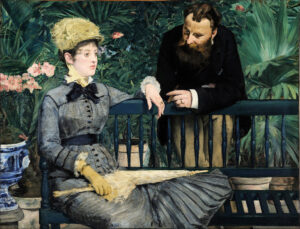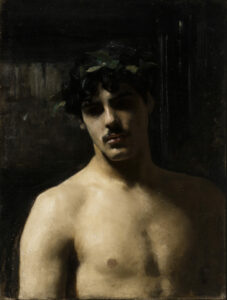
Stuttgart, 1802. Returning from Paris, Gottlieb Schick immortalizes Heinrike Dannecker, wife of his master sculptor. In the salon of the “Danneckerei,” a favored gathering place for art lovers, this portrait is born—vibrant with surprising modernity.
A Silhouette Between Heaven and Earth
Heinrike is seated on a stone bench evoking Antiquity. Her frank gaze addresses us directly. The deep blue dress drapes her body in an ample, natural movement. Blue, white, red: the colors of the tricolor flag are no coincidence. They celebrate the new feminine confidence following the French Revolution. Her right hand holds a rustic bouquet: bluebell, rose, buttercup, clover. These wild flowers contrast with the elegance of the pose. At her feet, wild grasses reinforce this impression of spontaneity. This painting reveals Schick’s talent in rendering textures.
Neoclassicism in Service of the Individual
Schick studied for four years under Jacques-Louis David in Paris. From this experience, he brought back neoclassical rigor and a love of pure contours. But here, academicism serves life itself. The background landscape fades into ethereal tones. Sky, valleys, rivers, mountains compose a harmonious horizon. Heinrike’s pose is inspired by the antique sculptures her husband collected. Schick merges classical ideal with individual vitality. “What happiness I felt in painting her portrait!” he confides in a letter to Dannecker.
Gottlieb Schick
Gottlieb Schick (1776-1812) embodies German Neoclassicism. Trained in Paris, he developed a refined style where line takes precedence. This portrait ranks among his masterpieces.
Think about it
💭 What if this portrait was less a tribute to a wife than a silent manifesto of feminine emancipation?
About this work
- Portrait of Heinrike Dannecker
- Gottlieb Schick
- 1802
- Oil on canvas
- 119 x 100 cm
- Staatliche Museen zu Berlin, Alte Nationalgalerie
- https://id.smb.museum/object/960902/bildnis-der-heinrike-dannecker






